Prices have been brought up to date, and are for stamps in 'average' condition. The currency is now selectable, the default is British Currency (£). I have revised Hiscocks' original listing, though leaving references to the original designations. The new designations have 'RH' numbers (Revised Hiscocks) to avoid confusion. Setup |
Steve Hiscocks wrote:
Like most main line railway companies the South Eastern Railway permitted use of its telegraph system by the public but it did not initially issue
stamps. In 1860 the Company opened an office near the big military camp at Aldershot (about 30 miles/50km West-Southwest of London). The military authorities
found small cash payments inconvenient and stamps were therefore issued on 1 September 1860. Although these were valid throughout the
Company's system they might almost be considered the first military telegraphs and the only private military stamps. They were designed
and printed by Charles Whiting of London and were used until the system was taken over by the Postmaster-General on 1 February 1870. Use was
small with only two printings amounting to 25,000 stamps in all The plates and remainders were destroyed in 1870. Imperforate proofs without
controls are known but are very rare. Two or three different perforations are known and these probably correspond to the two printings.
Cancellation was by date and initials in black manuscript.

4 examples sold by, and courtesy of, Grosvenor Auctions for £1650.
| Shortcuts to different sections: | ||||||||||||
| 9d | 1s | 1s2d | 1s6d | 2s3d | 2s9d | Proofs | Watermark | Control numbers | Plate layout | Perforations | Continuing research | Stationery |
The first series were Perf.9 in the values 1s, 1s6d, 2s3d and 2s9d. Most of these are extremely scarce, but the 1s used and 2s3d mint seem relatively common.
The second series (Late 1862 / early 1863) were Perf.12 (actually about 11.9) in the values 9d, 1s, 1s2d and 1s6d.
Lastly, about 1868 according to Langmead & Huggins, they became a higher perforation for just the 1s and 1s6d values.
Langmead & Huggins give this as 12 x 12½, but I agree with Hiscocks that they measure 12½ (actually a bit over).
For the shilling values, this is control numbers over about 53000. Langmead & Huggins say it is for controls around 19000 on the 1s6d, but my measurements of controls 19003, 19006 and 19053 give me Perf. 12.
It has to be said that most of these have poor quality, unevenly spaced perforations that can give different results depending on where you measure.
Peter Langmead is acknowledged in Hiscocks' book for having checked his GB section.
According to Langmead & Huggins these were printed in sheets of 12 or 24 and the
Royal Philatelic Collection has proof sheets of 24 of the 1s in both black and the issued colour (imperf. No controls), together with a sheet of 12 of the 9d in red.
My reconstructions for the 2s3d and 2s9d show that they had rows of 6 stamps and were numbered left to right.
At least some of the 1s2d though were numbered from right to left.
Scans I have collected give an idea of relative scarcity.
Note that 'P' in brackets indicates that they were in lot 1021 of the Phillips auction of the John Lowe collection.
This was 2 November 1990 when lot 1021 consisting of 6 stamps went for £240.
The lot was bought by Andrew Higson and the 1s2d(2001), 2s3d(1411) and 2s9d(620) are now in my collection.
Additionally, the catalogue of the Royal Philatelic Collection lists (without details):
Perf.9 - 1s x 2 used, 1s6d used, 2s6d mint, 2s9d x 2 mint;
Perf.12 - 9d x 2 used, 1s x 2 used, 1s2d mint, 1s6d mint + 1 used;
Perf.12½ - 1s x 2 mint, 1s6d mint.
Additionally there are a number of proofs, notably including sheets without controls : 9d red sheet of 12, 1s black sheet of 24 1s yellow sheet of 24.
These are thought to be all in rows of 6, but it isn't stated.
For what it's worth, here is a breakdown of usage by year for images I have :
For completion, earliest and latest :
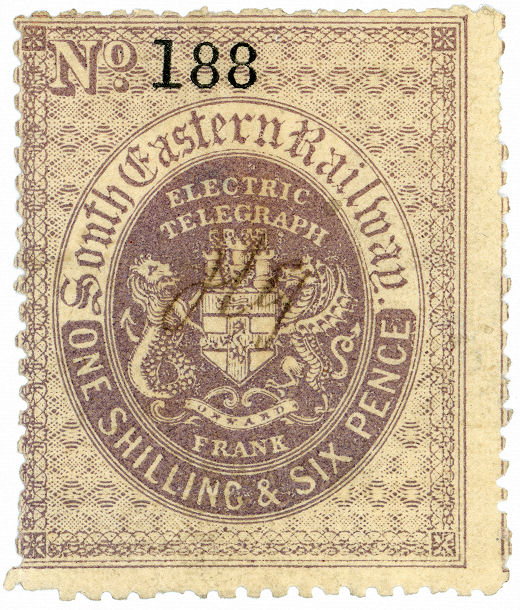 |
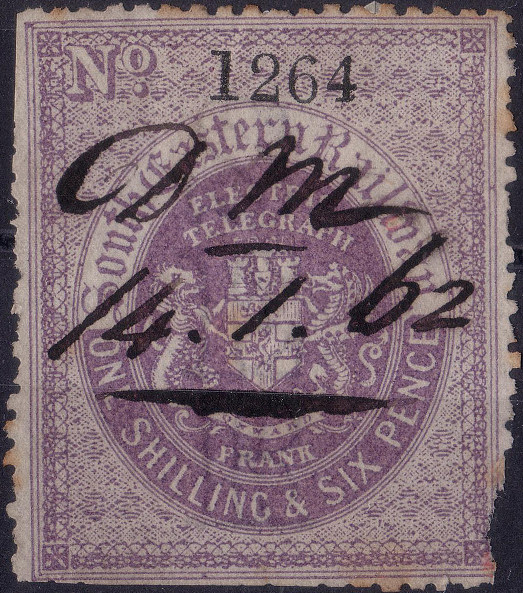 |
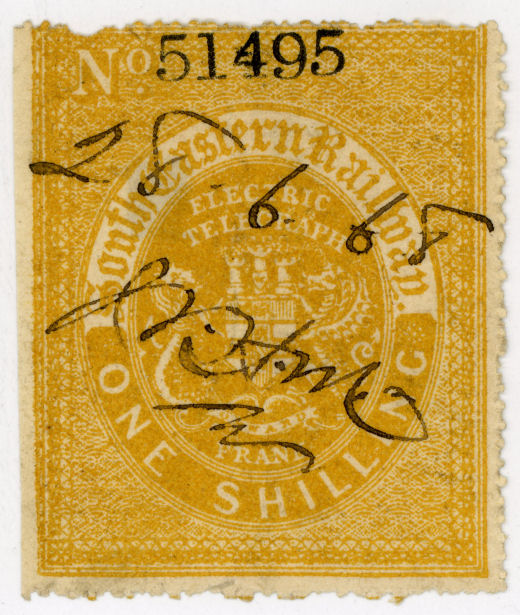 |
| Undated 1s6d numbered 188 - courtesy of Mark Gibson | 14 / 1 / 1862 1s6d numbered 1264 - courtesy of Steve Lawrie | 28 / 6 / 1868 1s numbered 51495 - courtesy of Mark Gibson |
Some were undated.
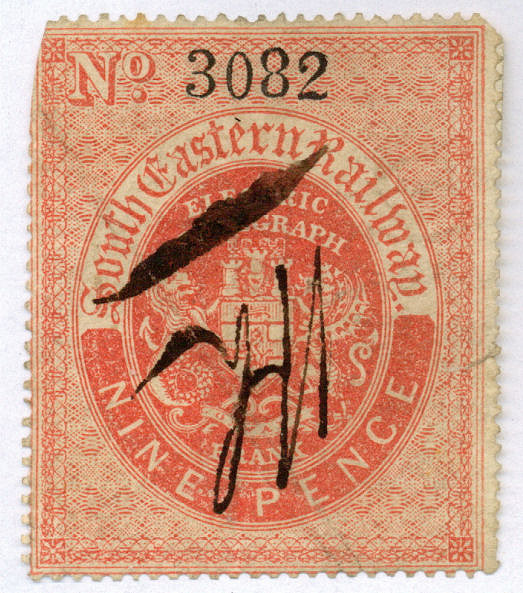 |
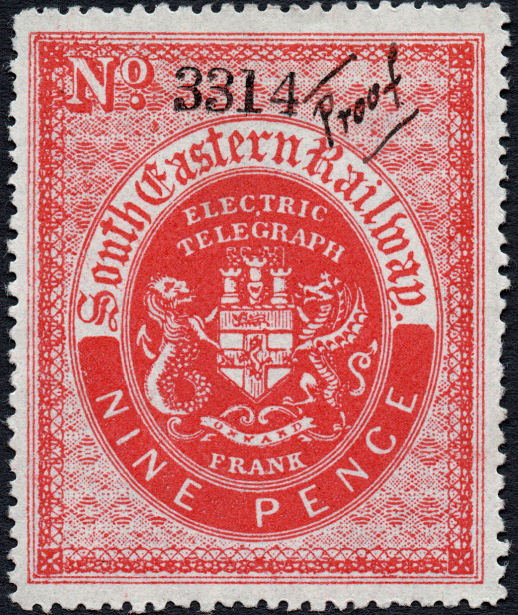 |
| 3082 - RH1a - 9d, Perf. 12 | 3314 - Proof of RH1 - 9d, Perf. about 10.7 |
| Image courtesy of Roger de Lacy-Spencer. | Image courtesy of Steve Lawrie. |
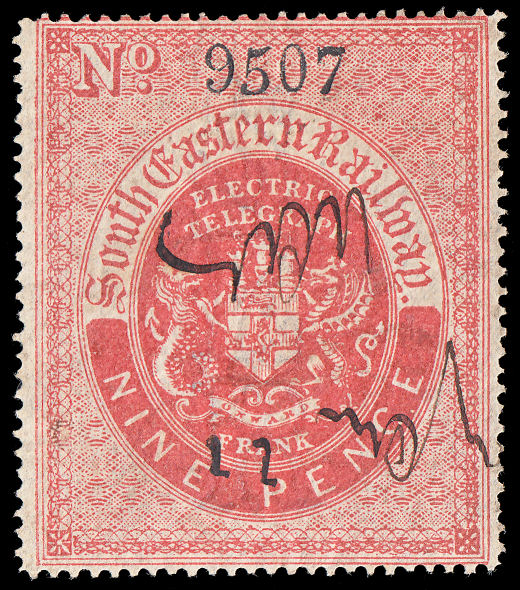 |
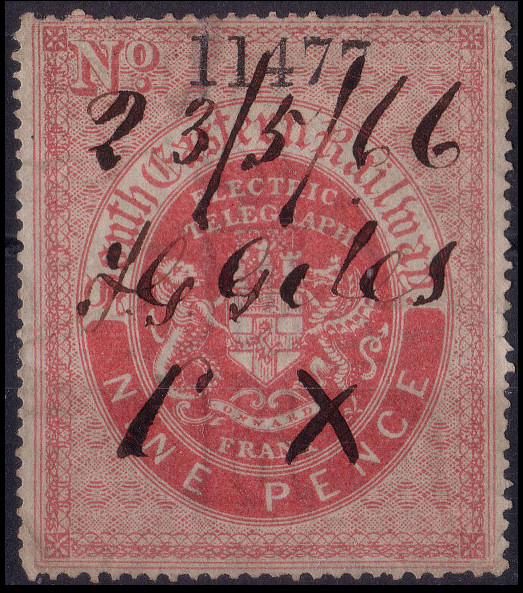 |
| 9984 dated 6/4/65 - RH1a - 9d, Perf. 12 | 11477 dated 23/5/66 - RH1a - 9d, Perf. 12 (Charing Cross) |
| One of mine. | Courtesy of Steve Lawrie. |
The stamp marked 'Proof' deserves a note. It looks very suspect on very white, presumably un-watermarked paper
with intermediate perforations and a control number smaller and slightly different in style to stamp 3082.
However the marks above 'No' at top left look like a fresher, though over-inked version of 3082, suggesting
it is an earlier print from the same plate using non-production paper, perforator and (arbitrary) numbering.
I invite you to compare it with the example of the scarce RH1b (proof without control) shown on the Distant Writing website.
I could be wrong of course.
I was informed by Dr Iain Stevenson FRPSL, that the original copper die for these stamps is in the RPSL Museum.
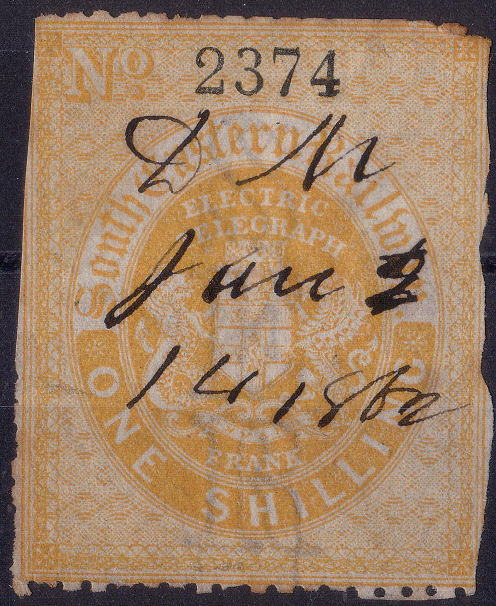 |
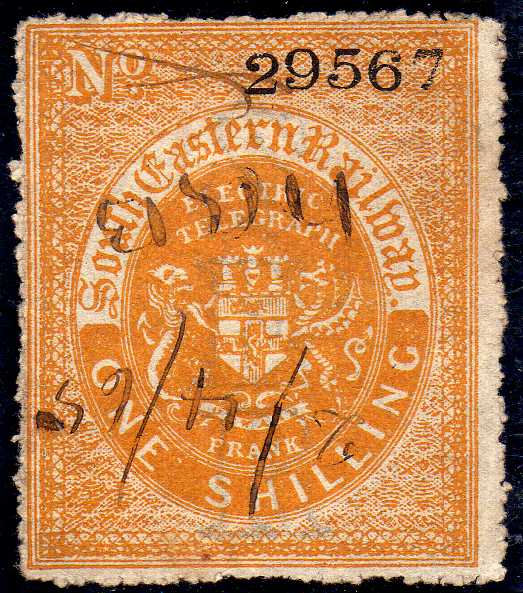 |
| Tall serial No. 2374 dated Jan 14 1862 - RH2 - 1s, Perf. 9 | 29567 dated 2/4/65 - RH2a - 1s, Perf. 12 (I think) |
| Image courtesy of Steve Lawrie. | Source: Andrew Higson. |
The differences in control numbers (value, not just size) together with the differences in date can give a guide to the rate of use.
In this case, 27193 in 38½ months, or about 700 per month. Some time between January 1862 and December 1864 the control number on the 1/- was reduced in height.
Somewhere between 39810 and 43007 (in 1866), they increased in height again, but not with the original font. It is rather strange, the first change might have been
because the first numbering machine only had four digits, but why the second? Surely a 5-digit machine shouldn't wear out before you get to the end of the count !
The 1/6d also had a change of font, around about the time of the colour change, but why ?
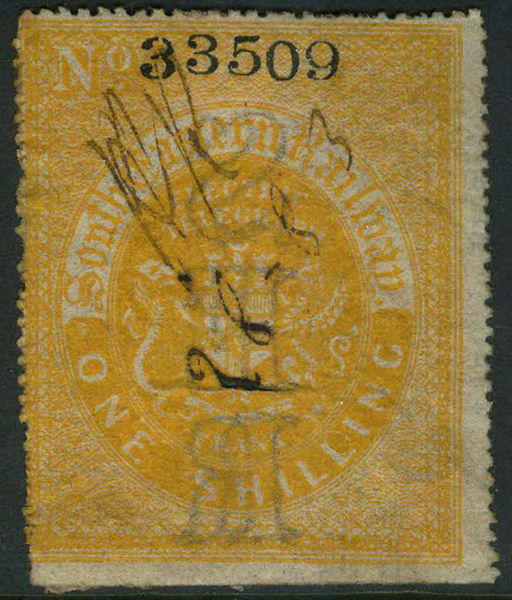 |
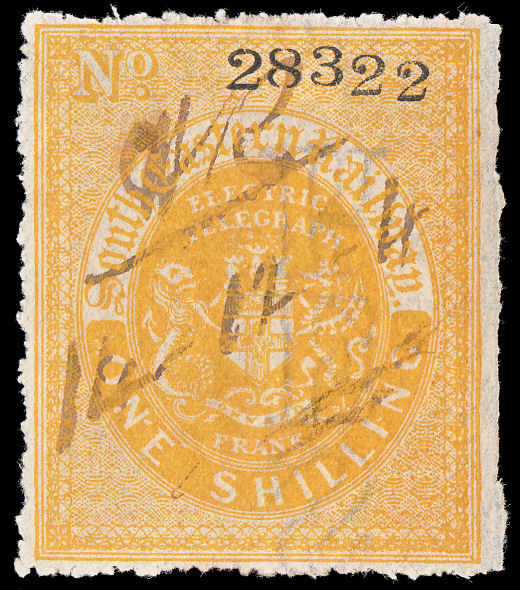 |
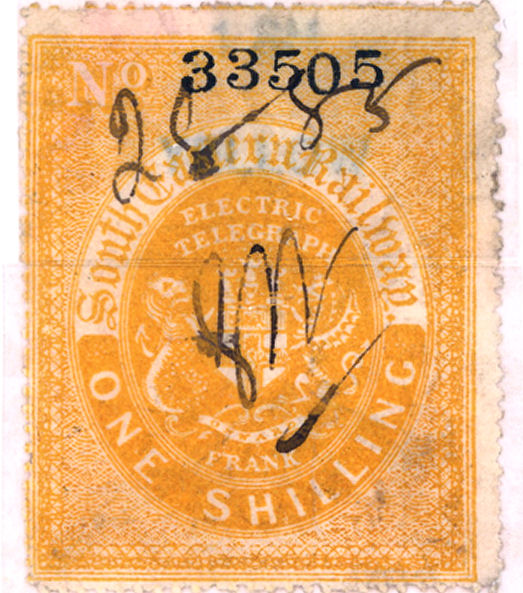 |
| 33509 - RH2b - 1s, Perf. 12x12½ showing reversed watermark. | 28322 - RH2b - 1s, (showing inverted-reversed watermark) | 33505 dated 28/8/65 ? RH2b - 1s, Perf. 12x12½ |
| Image courtesy of Philangles Ltd. | One of mine. | Courtesy of Mark Gibson. |
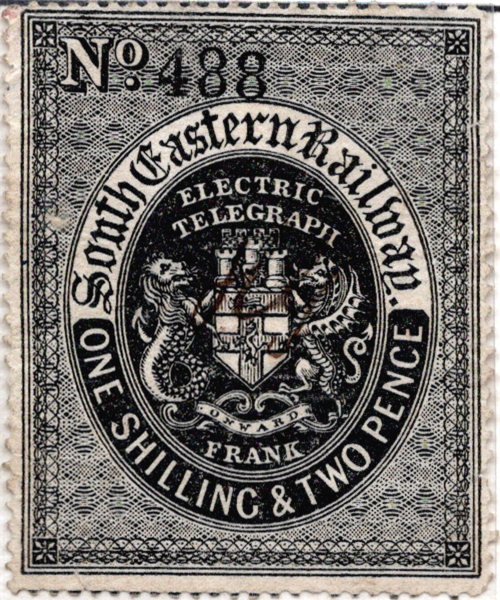 |
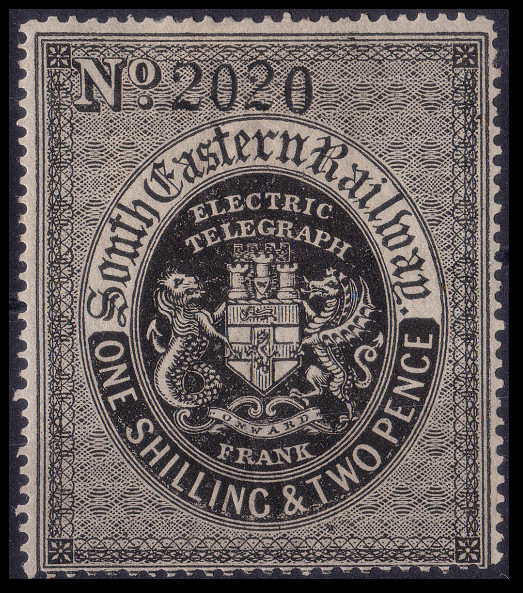 |
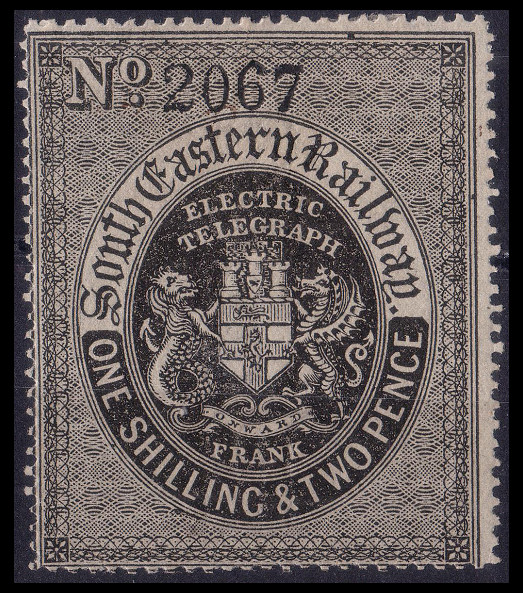 |
| 488 - RH3 - 1s2d, Perf. 12 (only used example seen) | 2020 - RH3 - 1s2d, Perf. 12 | 2067 - RH3 - 1s2d, Perf. 12 |
| Image courtesy of Mark Gibson. | Images courtesy of Steve Lawrie. | |
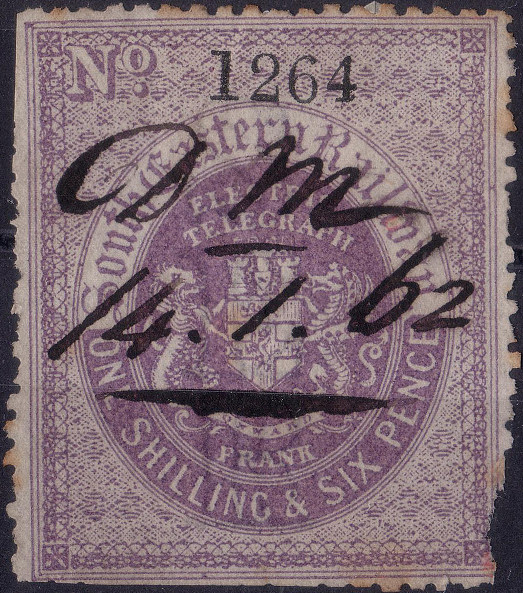 |
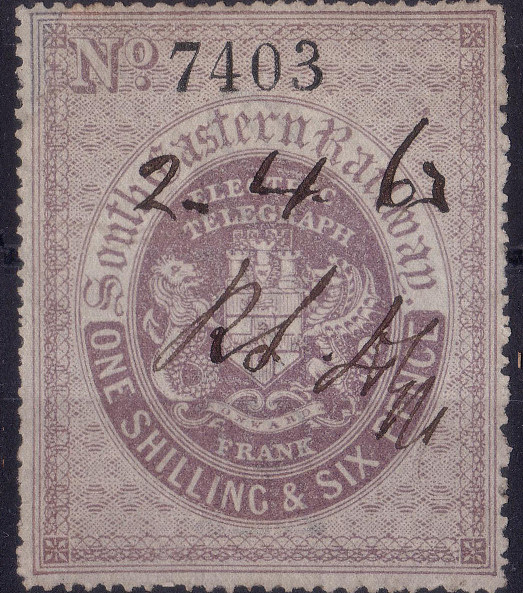 |
| 1264 dated 14/1/62 - RH4 - 1s6d, Perf. 9 | 7403 dated 2/4/63 - RH4a - 1s6d, Perf. 12 |
| Images courtesy of Steve Lawrie. | |
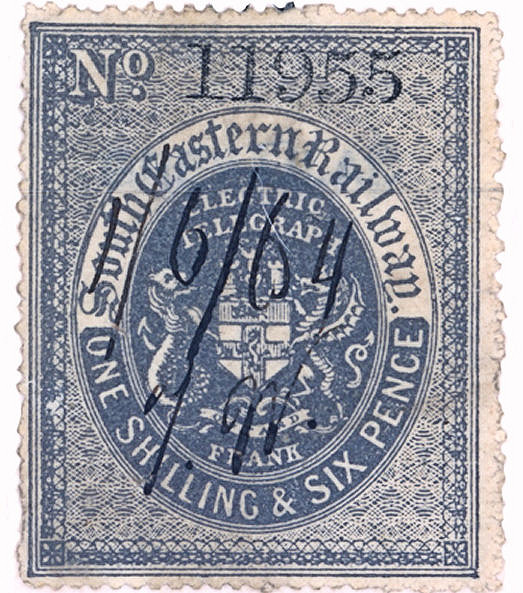 |
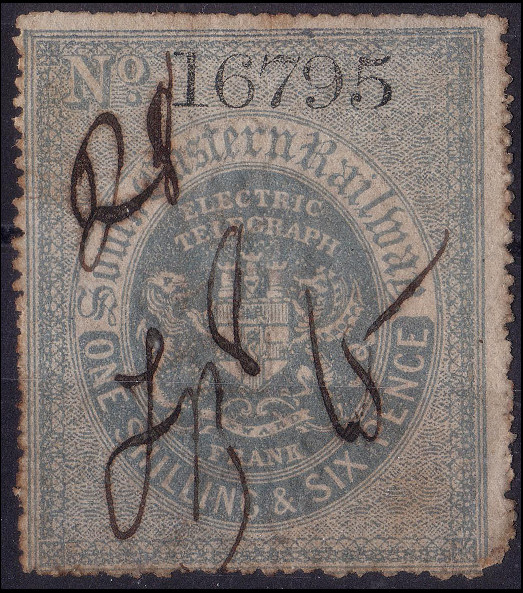 |
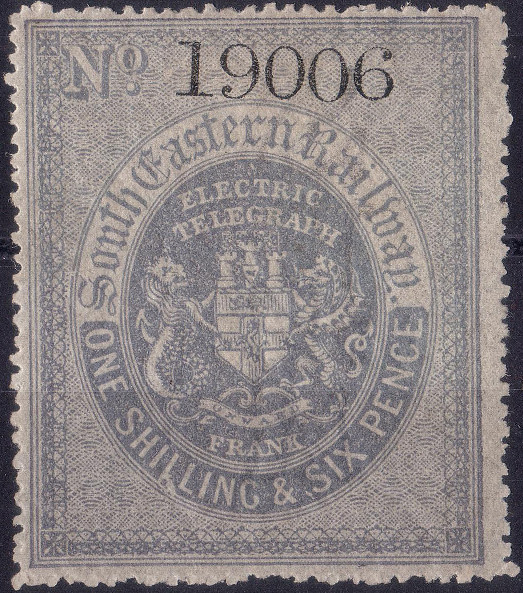 |
| 11955 dated 1/6/64 - RH4a - 1s6d, Perf. 12 | 16795 dated 28/8/65 ? - RH4a - 1s6d, Perf. 12 | 19006 - RH4b - 1s6d, Perf. 12 x 12½ |
| Image courtesy of Mark Gibson. | Images courtesy of Steve Lawrie. | |
Between controls 7403 (2/4/63) and 11955 (1/6/64) there appears to be a quite drastic change in shade !
It would be nice to try to narrow down when this happened. The size and font of the control numbers have also changed, that is less explicable.
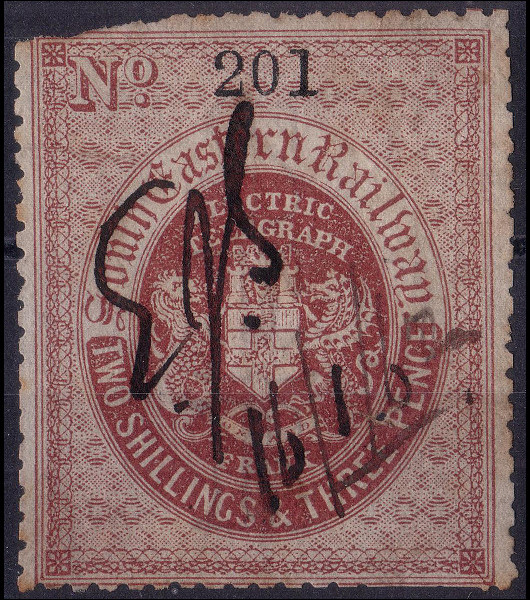 |
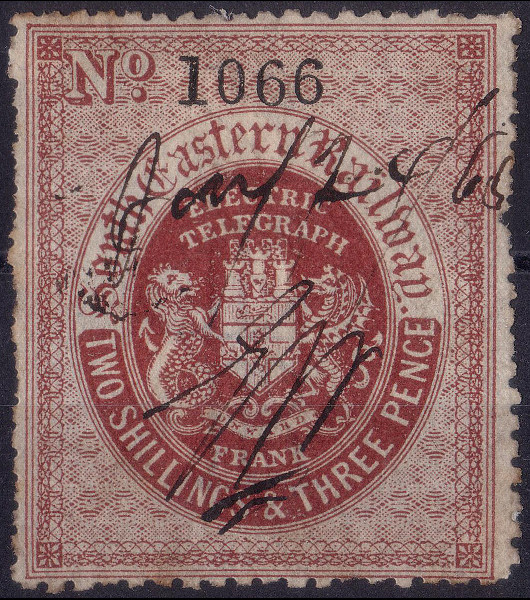 |
| 201 dated 16/1/62 - RH5 - 2s3d, Perf. 9 | 1066 dated 2/4/65 - RH5 - 2s3d, Perf. 9 |
| Images courtesy of Steve Lawrie. | |
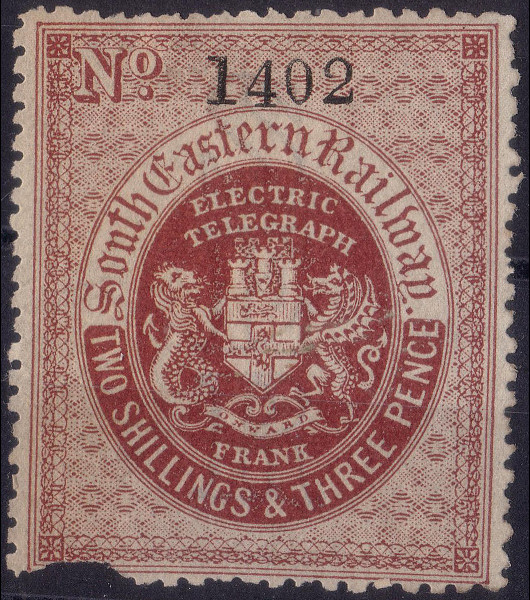 |
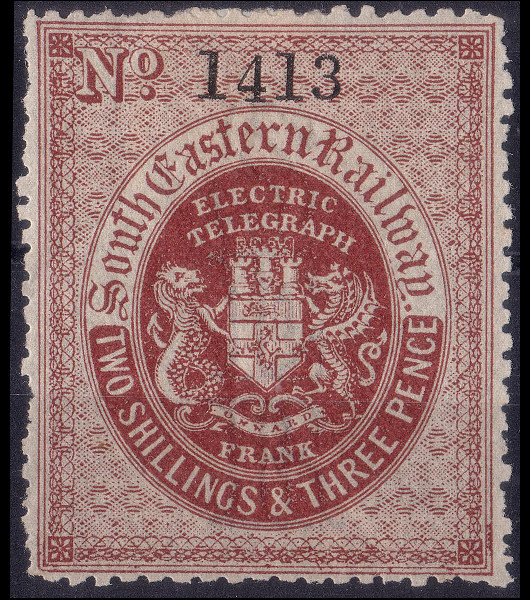 |
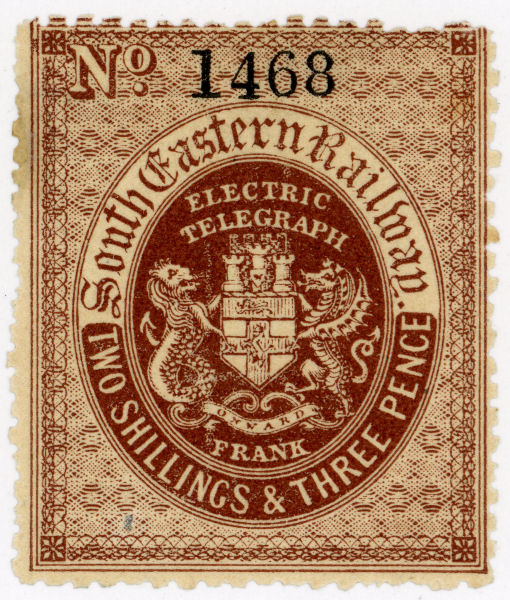 |
| 1402 - RH5 - 2s3d, Perf. 9 | 1413 - RH5 - 2s3d, Perf. 9 | 1468 - RH5 - 2s3d, Perf. 9 |
| Images courtesy of Steve Lawrie. | Image courtesy of Mark Gibson. | |
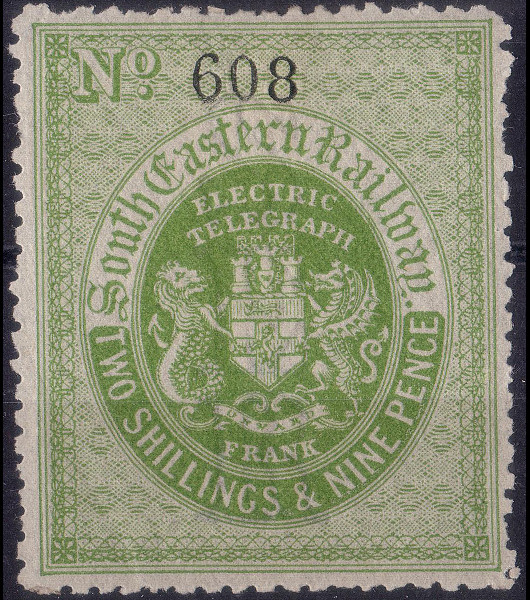 |
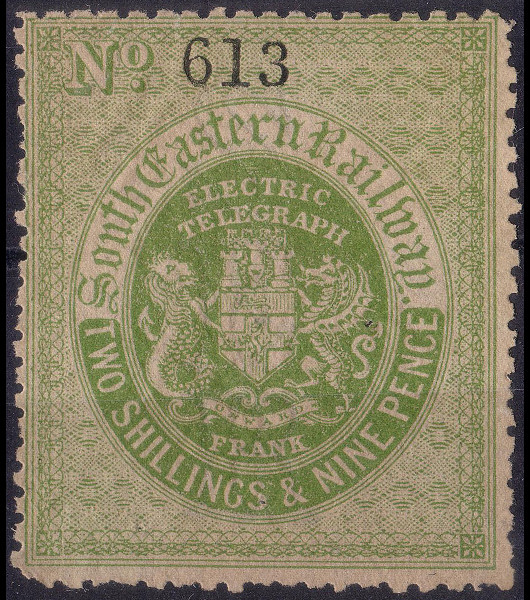 |
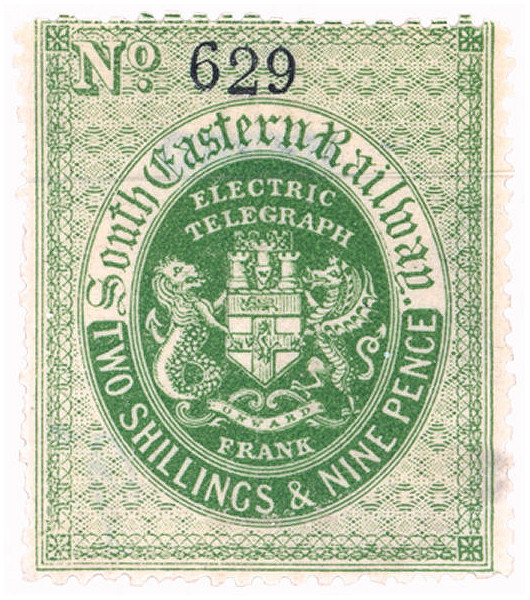 |
| 608 - RH6 - 2s9d, Perf. 9 | 613 - RH6 - 2s9d, Perf. 9 | 629 - RH6 - 2s9d, Perf. 9 |
| Images courtesy of Steve Lawrie. | Image courtesy of Mark Gibson. | |
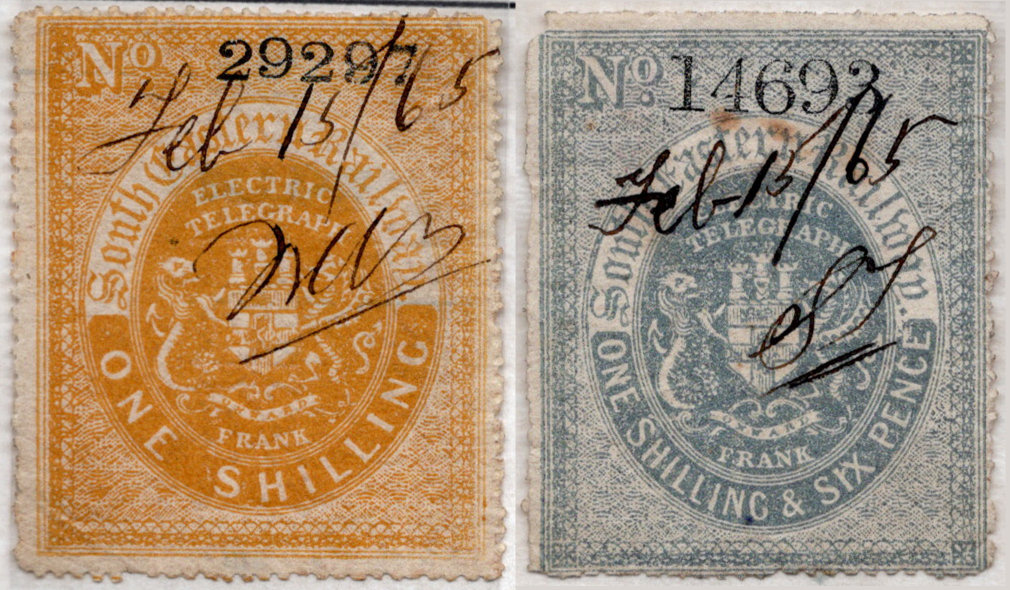
These two, both used on 15 February 1865, appear to have the date written in the same hand.
However they are initialled by different people. Note that most dates on these would be written like 15/2/65.
Perhaps the desk clerk affixed the stamps and dated them and the telegrapher initialled them after sending.
Alternatively, perhaps they were dated later by an inspector.
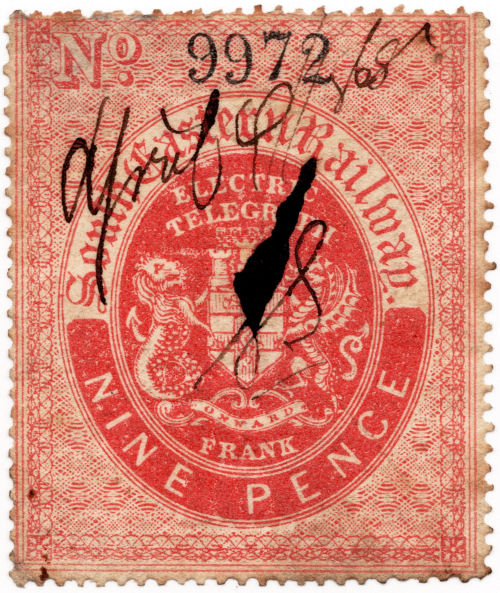
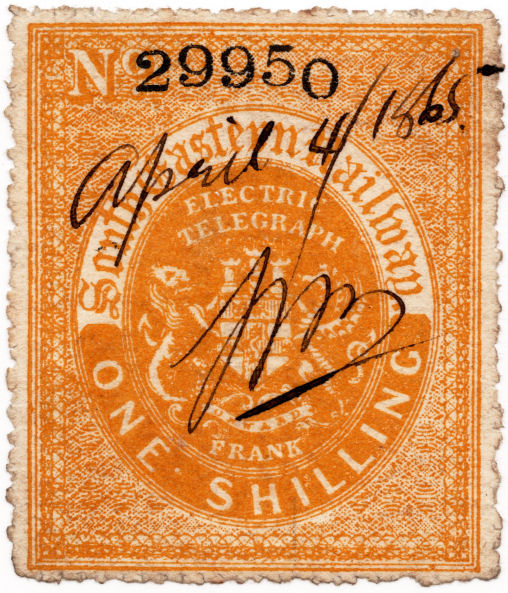
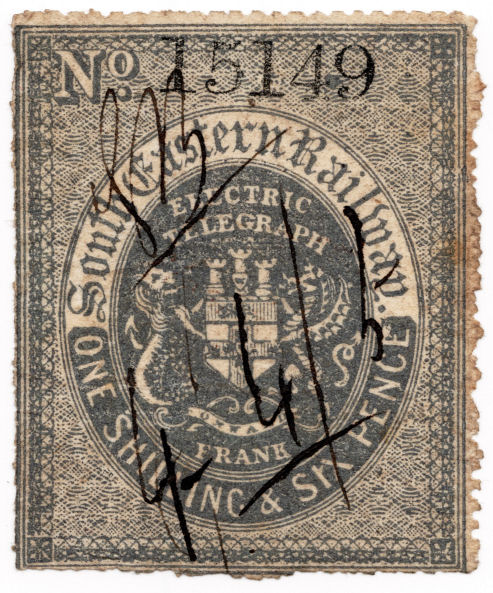
Here are three images that came as a batch from Mark Gibson. They are all used on 4 April 1865, though the 9d could be misinterpreted.
Note the different handwriting styles. Also the different control numbers on that date gives an idea of comparative usage.
Proofs of all values exist, with the 9d being the odd one out.
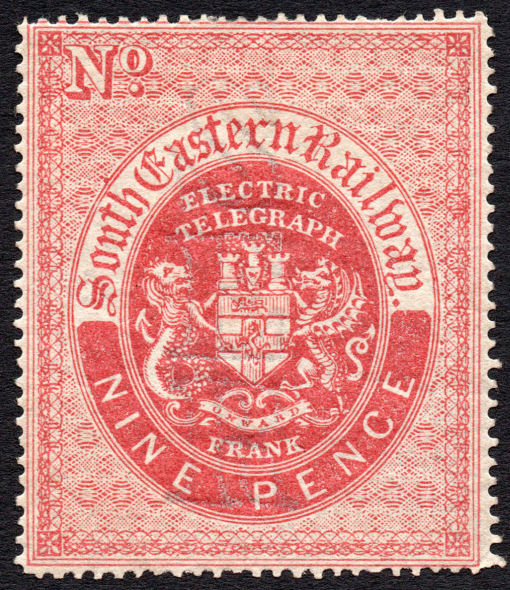
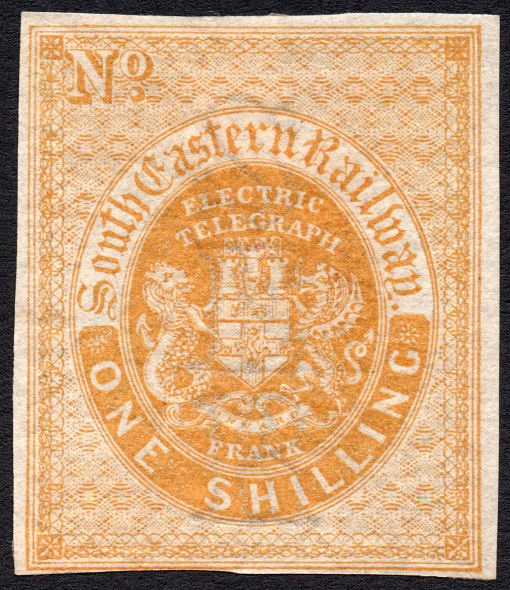
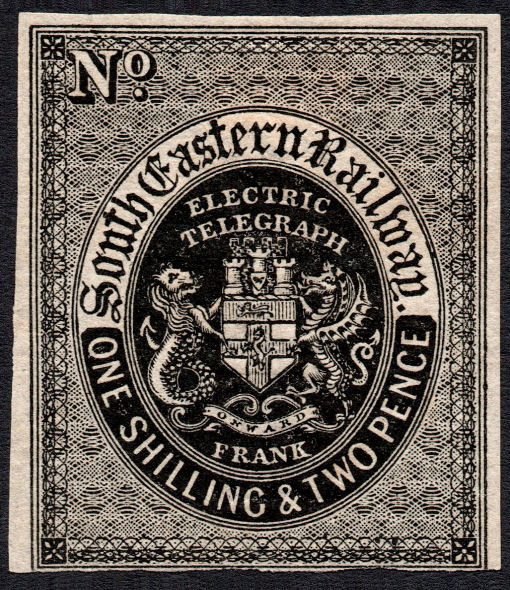
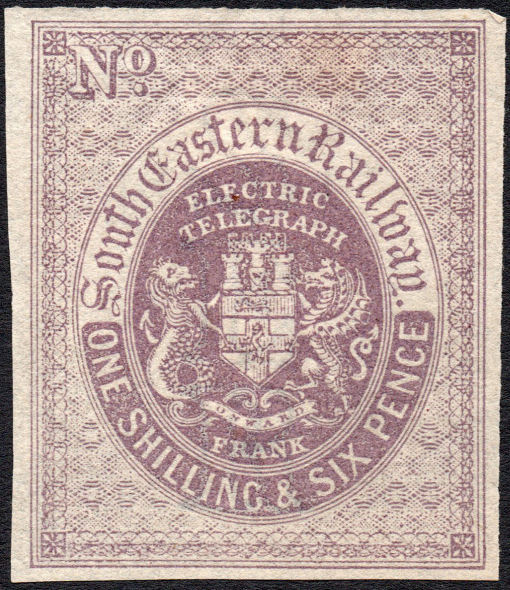
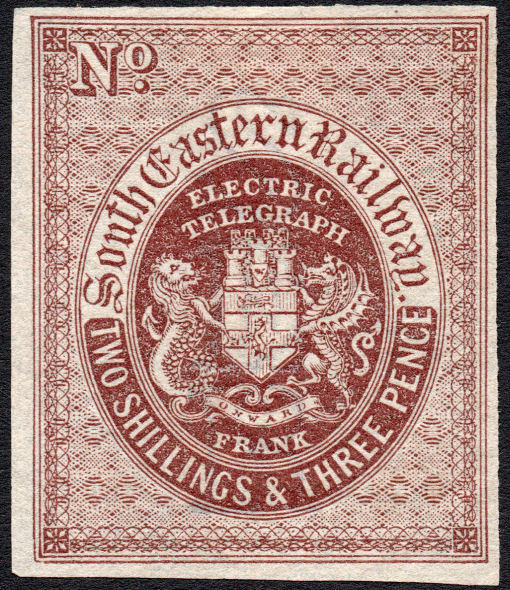
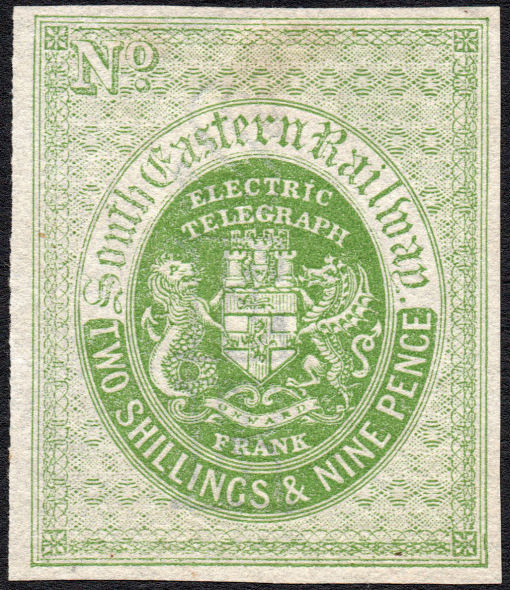
I have seen 3 examples of 9d proofs, including the one numbered 3314 above, and they have all been perforated, with the rest being imperforate. All of these are courtesy of Steve Lawrie.
Interestingly, they are all watermarked, except perhaps the 1s 2d that cannot be seen.
The watermark (shown above) is most clearly visible on the 1s stamps.
it can be seen in various orientations.
| Orientation | Qty | 1s Controls |
|---|---|---|
| Normal | 17 | 2374, 15315, 15320, 29297, 29567, 29950, 33399, 39810, 43007, 46462, 51495, 53004, 53007, 53053, 54756, 54757, 54759. |
| Reversed | 4 | 33505, 33509, 33514, 33706 |
| Inverted | 0 | |
| Inverted-Reversed | 1 | 28322. |
| Unknown | 1 | 33571 |
| Total | 23 | Range 2374 - 54759 |
The normal ones are spread over a wide range of control numbers, but the reversed ones are mostly from the same sheet.
Most of the 1s could be determined from scans on dark backgrounds. Though the other denominations are less easy to see, the proportions are probably similar
These figures though are heavily influenced by the close numbering of the reversed ones.
On the 9d stamp scans, 9984 and 11477 can be seen to be normal, but the other 4 are uncertain.
That makes 4 normals and 2 unknowns (629 and 630).
On the 1s2d, 2001(mine) has a reversed watermark. Mark Gibson tells me that 2006, 2017, 2018 and 2019 are also reversed. These are probably from the same sheet.
On the 1s6d (with enhancement) I can see a normal watermark on 188, 1264, 7403, the lilac ones, but really can't be sure on the (7) later grey-lilacs,
though the last two, 19003 and 19006 look like they may be reversed. Mark Gibson tells me that his 19053 is reversed. Again, probably all the same sheet.
On the 2s9d, 608, 613 and 620(mine) can be seen to be normal. 619 adjoins 620 so must be normal.
That makes 4 normals and 2 unknowns (629 and 630).
Similarly, the 2s3d is helped by 1419 being visibly normal and fitting into a block with 1417, 1418, 1420, 1423 and 1424, so that they must also be normal.
924, 1402 and 1413 can just about be seen (with enhancement) to be normal, making 9 normals and only 3 unknowns (201, 1066 and 1411).
On the 1s2d scans, I cannot make out even a hint of a watermark.
Unusually, pairs 2017/2018 and 2020/2021 only fit together numbered right to left.
2017, 2018 and 2020 are shown on this page, 2021 is illustrated in the Langmead & Huggins book.
As pointed out in passing on the shilling values, the control numbers did not always stick to the same size and font.
Control numbers were important for accounting purposes and to deter crime. To avoid duplication of numbers, ideally the numbering for each denomination needs to be
done with the same (tamper-proof ?) numbering device. The devices should be reliable enough not to fail before the full count is reached.
The catalogue of John Barefoot first brought my attention to the fact that the size of control numbers on the One Shilling value changed.
I should have noticed it myself, but had not. Anyway, looking into it further, reveals that it changed twice and that the controls on the 1s6d also changed.
These are the two denominations that got to the highest control numbers.
| Denomination | Lowest control known | Highest control known | Quantity of types | Examples (to scale) |
|---|---|---|---|---|
| 9d | 3082 | 11477 | 1 | 

 |
| 1/- | 2374 | 54759 | 3 | 

 |
| 1/2d | 488 | 2068 | 1 | 

 |
| 1/6d | 188 | 19053 | 2 | 

 |
| 2s3d | 201 | 1468 | 1 | 


|
| 2s9d | 604 | 675 | 1 | 


|
For the purposes of this, I have ignored the 9d stamp marked 'Proof' as the control number is of unknown origin.
For the 9d, 1s2d, 2s3d and 2s9d, only one type appears to have been used, but they are not all the same, the '2's and '7's have
fairly ornate tops/bottoms on the 9d and 1s2d, but straight on the 2s3d and 2s9d .
The 1s6d changes size between 7403 (dated 2-4-63) and 11938 (dated 31-5-64).
It may simply be due to the first numbering device only having 4-digits, though the 9d went above that.
The 1s changed to a small size between 2374 (dated 14-6-62) and 28322 (dated 14-12-64). This is a big gap.
It changed again to a different large font between 39810 (dated 20-5-66) and 43007 (dated 8-8-66).
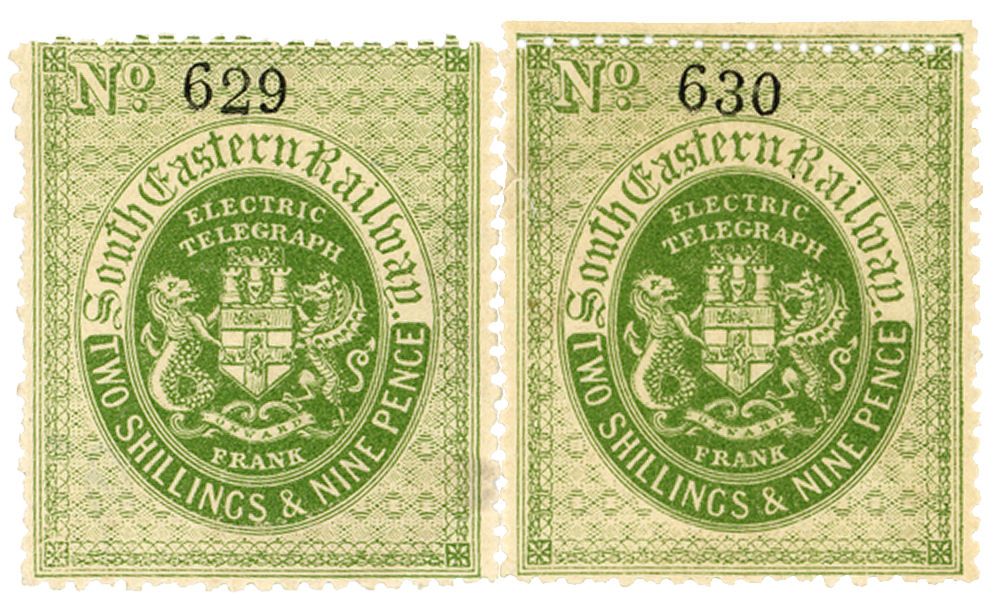
This pair courtesy of Mark Gibson shows that their horizontal numbering was left to right.
Here are the 5 scans I have from the row fitted in right to left order (half size, click it for a larger image).
Though the perforations fit together quite well, the stamps are not well aligned vertically, perhaps explaining why well-centred examples are scarce.

2020 is courtesy of Steve Lawrie, 2021 is from Langmead & Huggins' book (colour plate 2), courtesy of the Great Britain Philatelic Society.
2017, 2018 and 2019 are courtesy of Dr. Mark Gibson.
Anyone have 2016 or 2022, or perhaps something from above or below?
2068 has selvedge at the top. This helps to determine the number of rows of stamps in the sheet.
These four are perforated at the top, though the 1s values shown above are not.
Examples with Selvedge are useful in confirming how many stamps per sheet.
This is where things become a little unclear.
According to Langmead & Huggins, the 1868 issue were Perf. 12 x 12½ and comprised :
The 1s6d control 19053 is shown just above. It is perforated through the selvedge, measuring Perf.12.
I have scans of 1s6d with controls 19001, 19003, 19006 and 19053. They can best be described as Perf. 11¾.
The 1s stamps 53004 and 53053 are shown higher up. Their selvedge is without perforation, and they measure Perf. 12½.
I also have scans of 1s controls 54756, 54757 and 54759 which also measure Perf. 12½.
In conclusion, I have to totally disagree with them.
Raymond Lister (1961) listed the 1s and 1s6d as existing with Perf.12½ without stating control numbers. It is true for the highest controls of the 1s,
and may be true for the highest controls of the 1s6d, but if so they are higher than the 19053 seen.
Hiscocks says several things about the South Eastern Railway stamps that beg a question.
For the sake of interest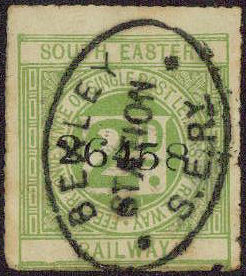
The 1892 South Eastern Railway cancel used for railway letters and telegraphs.
Image courtesy of Roger de Lacy-Spencer
| Shortcuts to different sections | |||
| Delivery form (191c) |
Delivery form (211a) |
Delivery form no number |
Envelopes |
This is front and back a form number (191 c) dated 25 February 1856. Courtesy of Steve Lawrie. - My Ref. SER-191c-1855-1
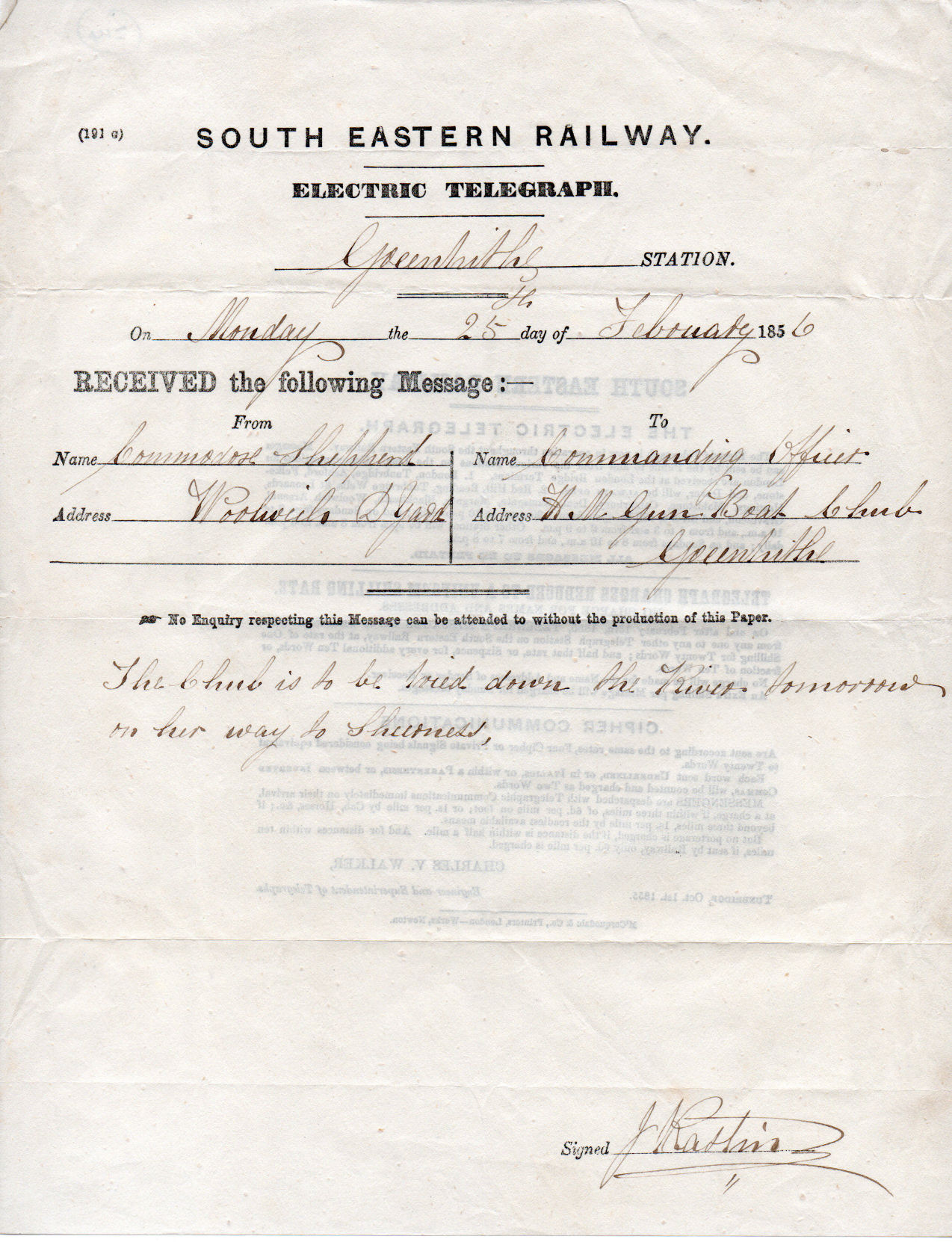
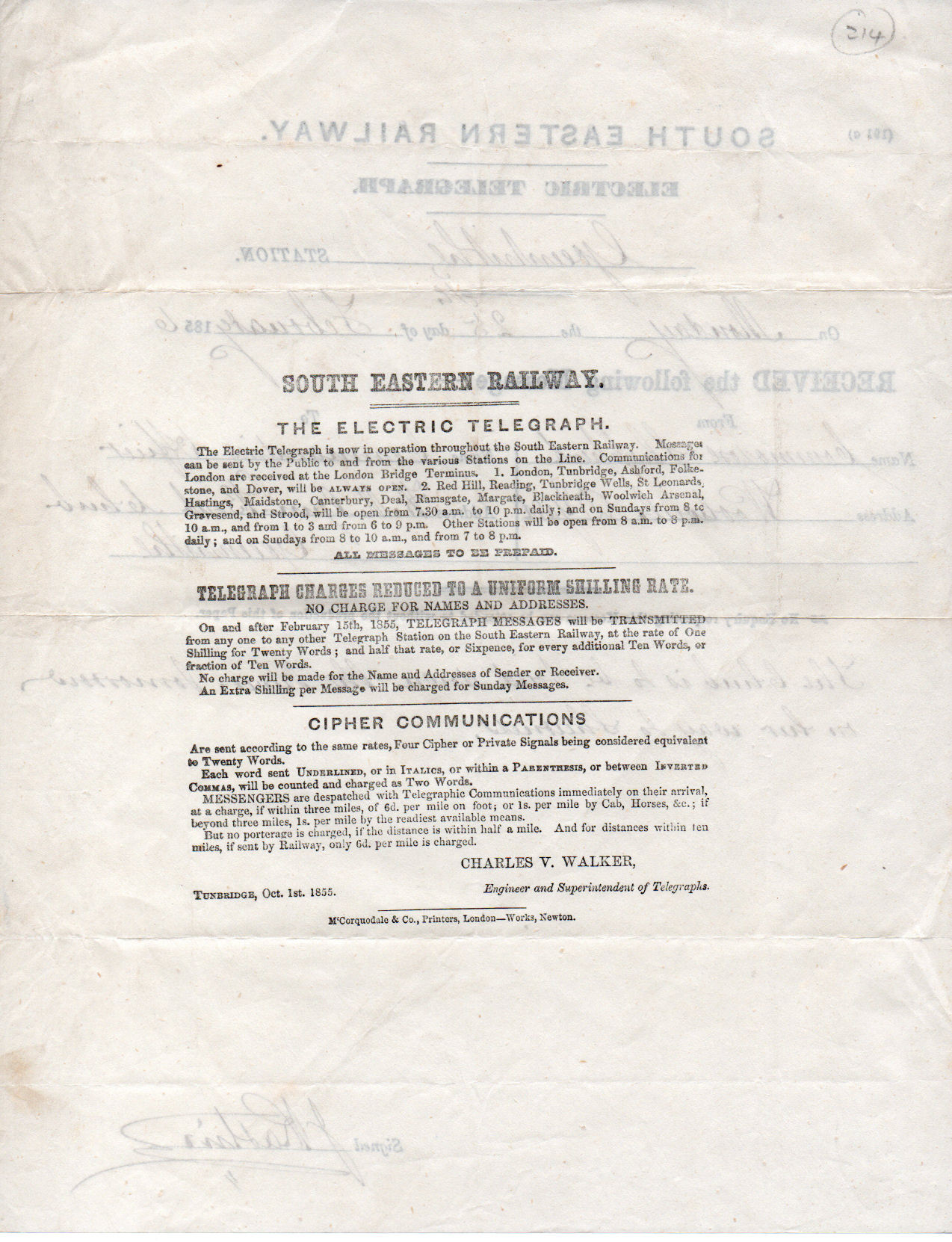
The back provides information and states "Telegraph Charges Reduced to a Uniform Shilling Rate. No charge for names and addresses."
It goes on "On and after February 15th, 1855, Telegraph Messages will be transmitted from any one to any other Telegraph Station on
the South Eastern Railway, at the rate of One Shilling for Twenty Words; and half that rate, or Sixpence, for every additional Ten Words,
or fraction of Ten Words. No charge will be made for the Name and Addresses of the Sender or Receiver. An Extra Shilling per Message will be charged for Sunday Messages."
Porterage is 6d per mile if more than half a mile, or 1s per mile if more than 3 miles.
It has the signature of Charles V. Walker, Engineer and Superintendent of Telegraphs.
Below that is "Tunbridge, Oct. 1st. 1855." and the imprint of the McCorquodale & Co., Printers, London—Works, Newton.
Courtesy of Steve Lawrie
This is front and back a form number (191 c) dated 25 June 1856 (4 months later). Courtesy of Mark Gibson. - My Ref. SER-191c-1856-1
The front is the same, but the back is significantly changed.
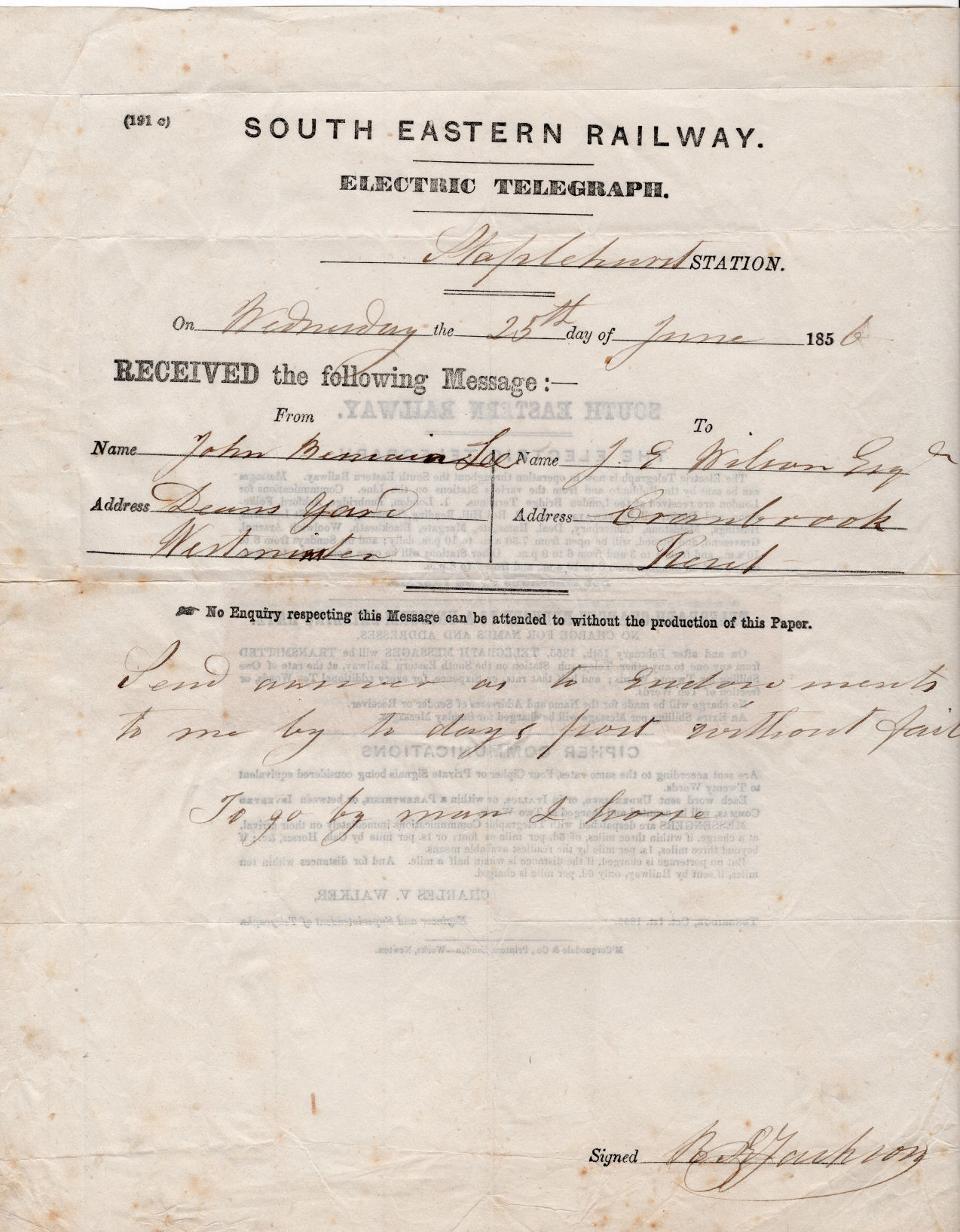
Back
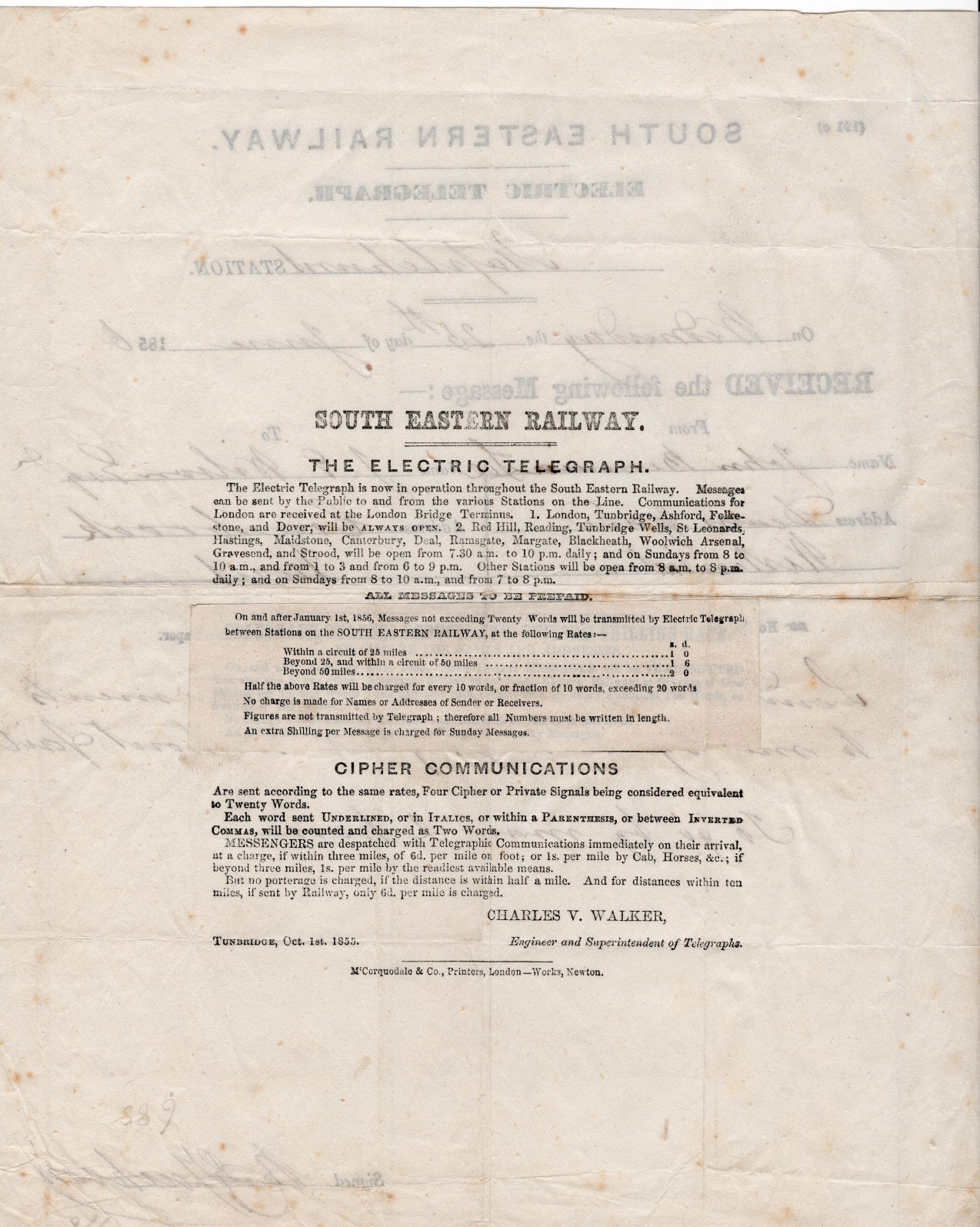
The rates section on the back has been pasted over with a revision, now reading "On and after January 1st, 1856, Messages not exceeding Twenty Words
will be transmitted by Electric Telegraph between Stations on the South Eastern Railway, at the following Rates :—
Within a circuit of 25 miles ............................1s0d
Beyond 25, and within a circuit of 50 miles .... 1s6d
Beyond 50 miles .......................................... 2s0d"
Half rates are the same, still no charge for names and addresses and still an extra shilling on Sunday, but an extra bit that reads
"Figures are not transmitted by Telegraph ; therefore all Numbers must be written in length."
Courtesy of Mark Gibson.
A similar form, but this marked form (211a), dated 1 January 1856 on the back, again showing front and back. - My Ref. SER-211a-1856-1
Used 3 March 1858, - courtesy of Brian Callan.
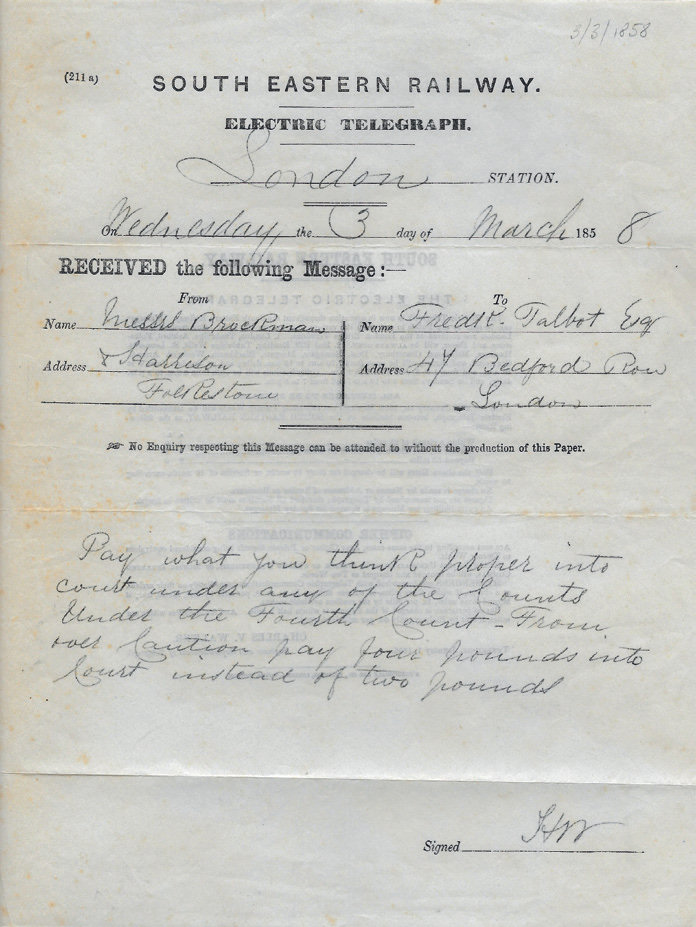
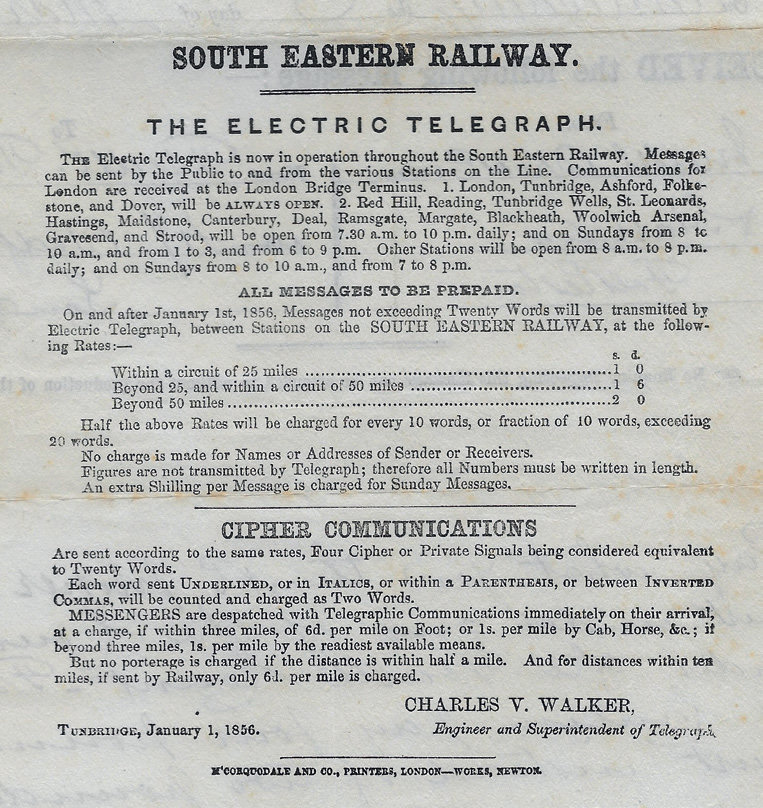
The back has now changed to reflect the pasted over notice on the last 191 form.
Courtesy of Brian Callan.
A similar form, but now dated 1 October 1861, again showing front and back - courtesy of Mark Gibson. - My Ref. SER-211a-1856-1
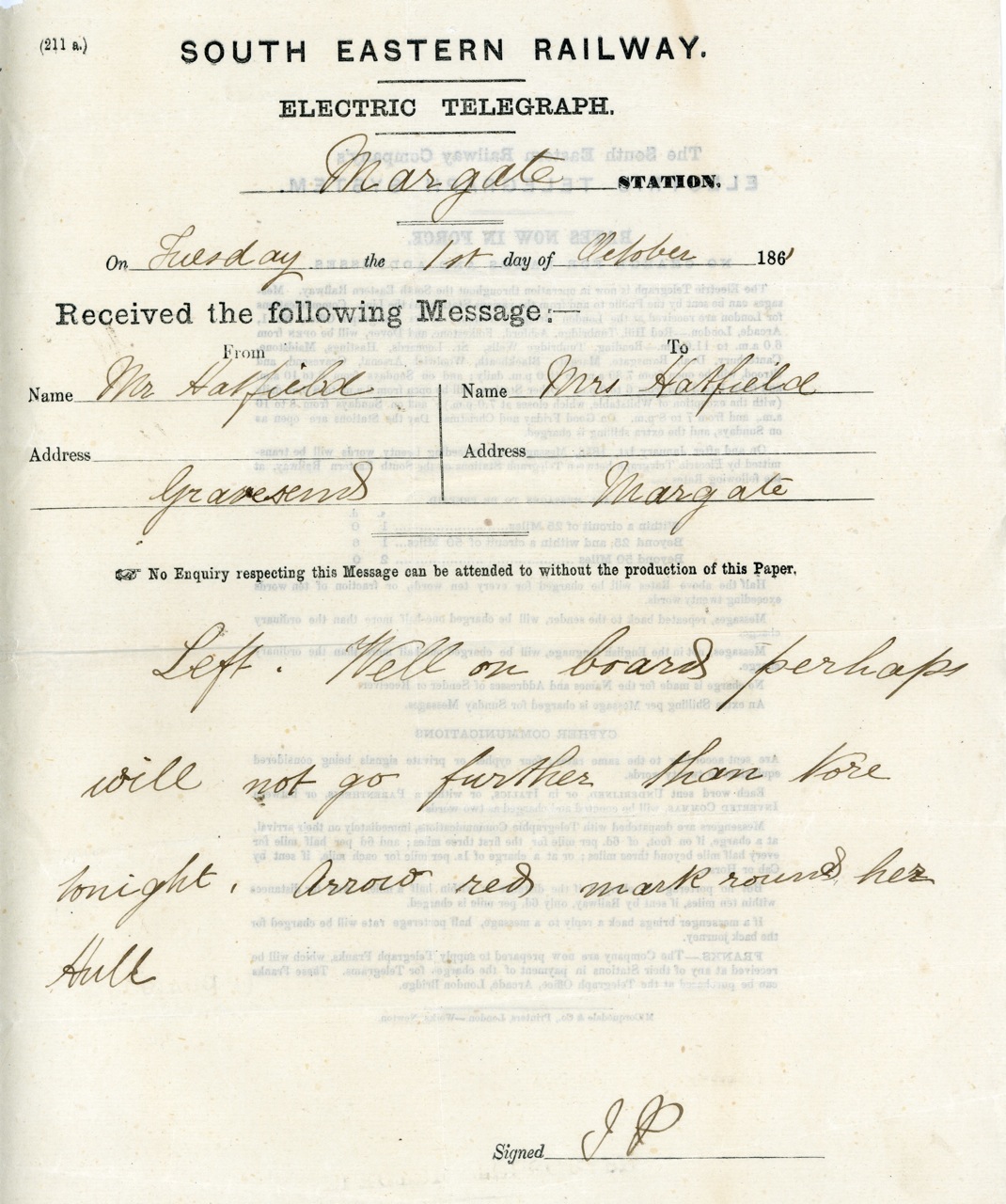
Back
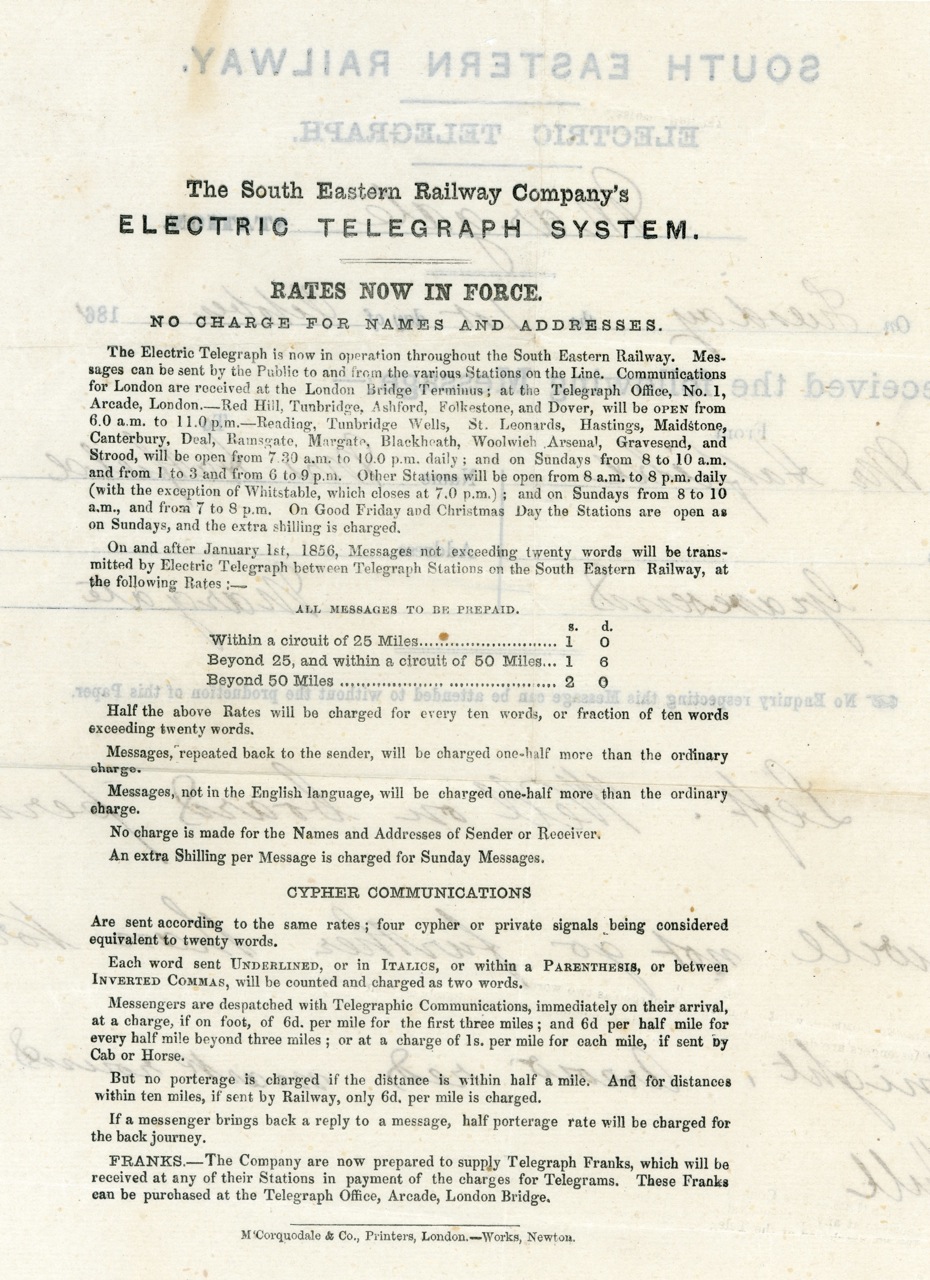
The back has now changed to reflect the pasted over notice on the last Form 191, though no mention of numbers being written at length, and the addition of
"Messages repeated back to the sender, will be charged one-half more than the ordinary charge. Messages, not in the English language, will be charged one-half more than the ordinary charge."
"FRANKS.—The Company are now prepared to supply Telegraph Franks, which will be received at any of their Stations in payment of the charges for Telegrams.
These Franks can be purchased at the Telegraph Office, Arcade, London Bridge."
Courtesy of Mark Gibson.
Front and back of another similar form from London to Rye, dated 11 June? November? 1865, now without a visible form number. - My Ref. SER-211a-1865-1
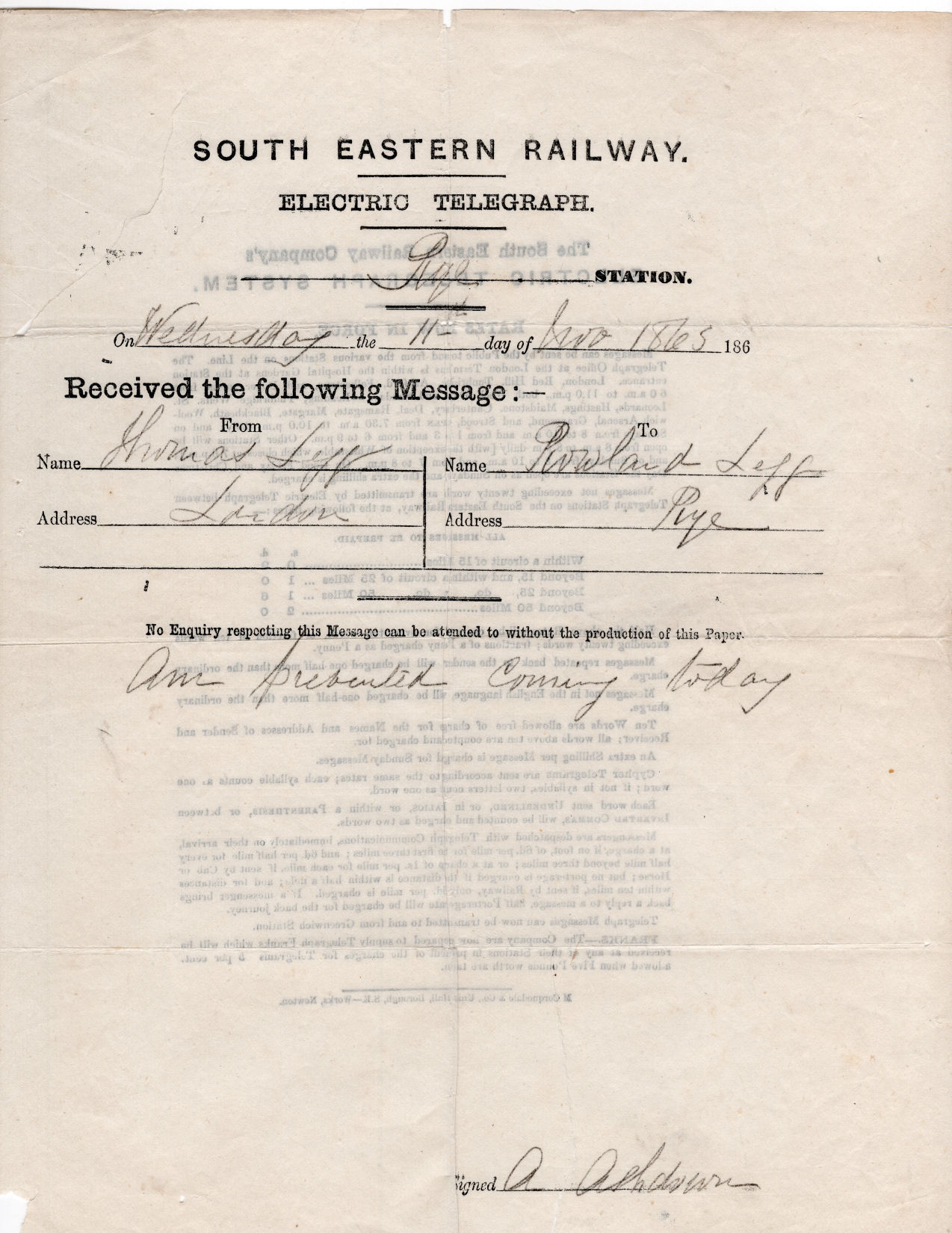
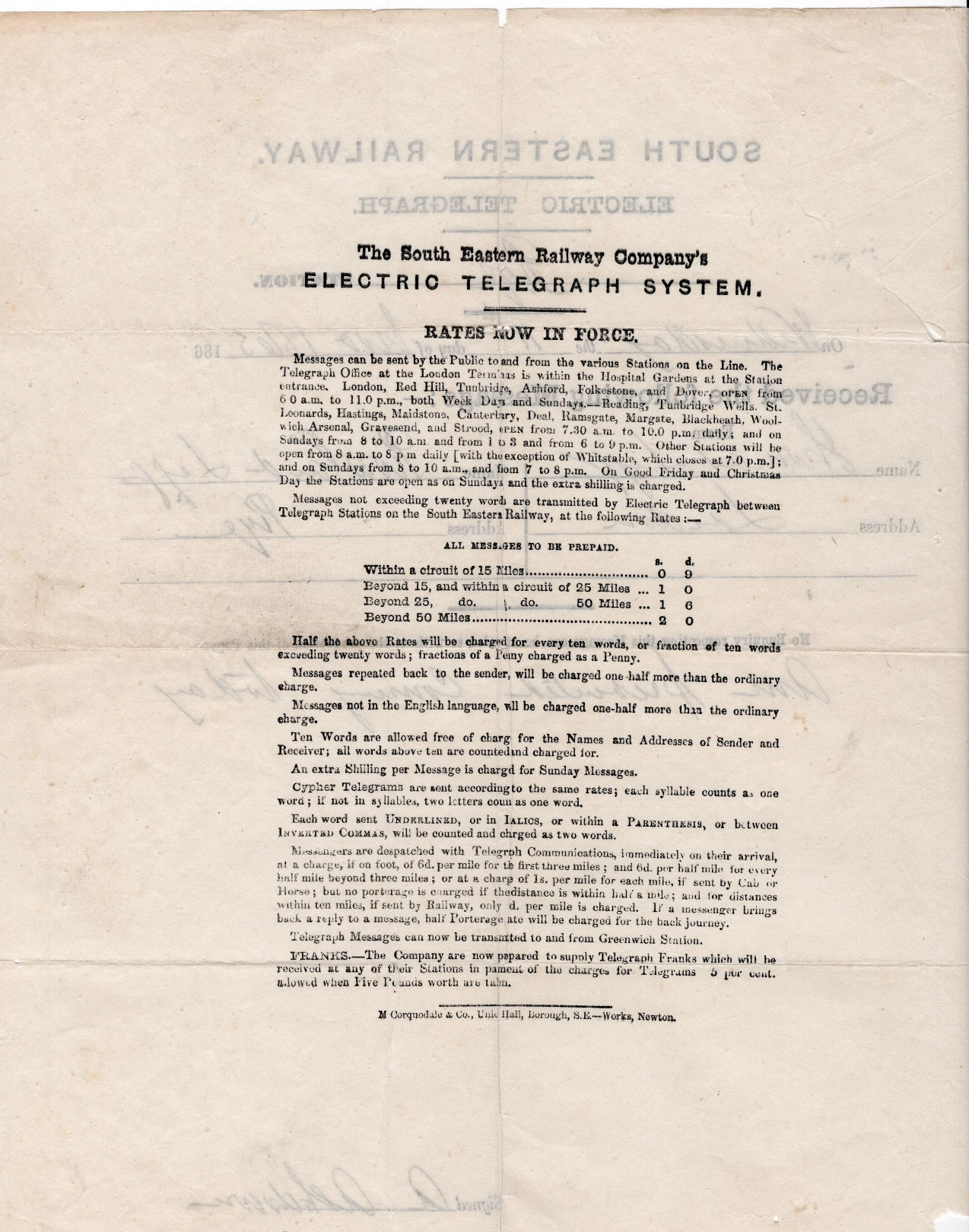
This has added the rate of 9d for distances of less than 15 miles, introducing the need for a 9d stamp.
Not only that, the additional "one-half more" clauses, when applied to it would cause problems.
Presumably the 9d and 1s2d stamps were introduced together as a result of this. - Image courtesy of Mark Gibson.
Delivery Form listing.
| Provisional Reference | Form number | Date on form | Dates used | Size mm. | Rates | Printer | Authority |
|---|---|---|---|---|---|---|---|
| SER-191c-1855-1 | 191 c | 1 October 1855 | 25/2/1856 | 216 x 280 | 1s for 20 words, 6d for each additional 10 words | McCorquodale & Co. | Charles V. Walker |
| SER-191c-1856-1 | 191 c | 1 January 1856 | 25/6/1856 | 216 x 270 | Pasted tariff, 20 words 25 miles: 1s; 50 miles 1s6d; over 50 miles 2s. +50% for each additional 10 words. | McCorquodale & Co. | Charles V. Walker |
| SER-211a-1856-1 | 211 a | 1 January 1856 | 3/3/1858 | ? | Printed tariff as above. | McCorquodale & Co. | Charles V. Walker |
| SER-211a-1861-1 | 211 a | 186_ | 1/10/1861 | 216 x 280 | Printed tariff as above. | McCorquodale & Co. | |
| SER-211a-1865-1 | - | 186_ | 11/11/1865 | 216 x 278 | Printed tariff: 9d up to 15 miles; 1s up to 25 miles; 1s6d up to 50 miles, or 2s above 50 miles. | McCorquodale & Co. |
A couple of delivery envelopes, Ex Andrew Higson, courtesy of Spink & Son.
Not a delivery envelope, just a normal 1855 envelope to J. R. Mowatt (the Secretary of) Great Northern Railway at Kings Cross.
It does though bear an embossed seal of the S. E. R. on the back, as well as a "South E Ry." red backstamp.
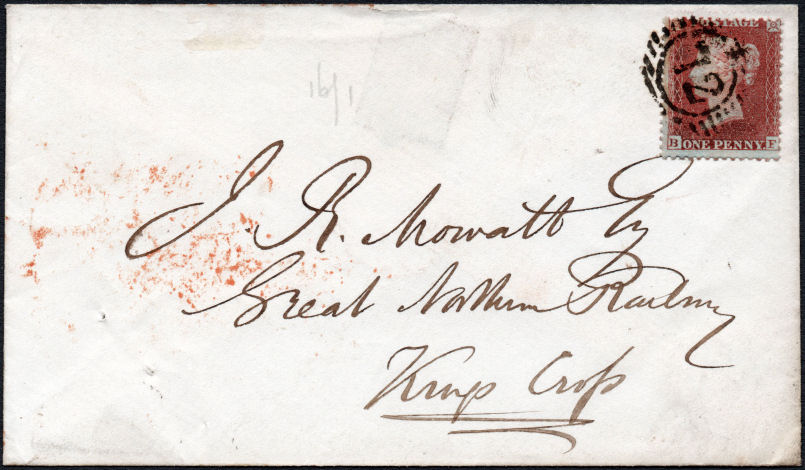
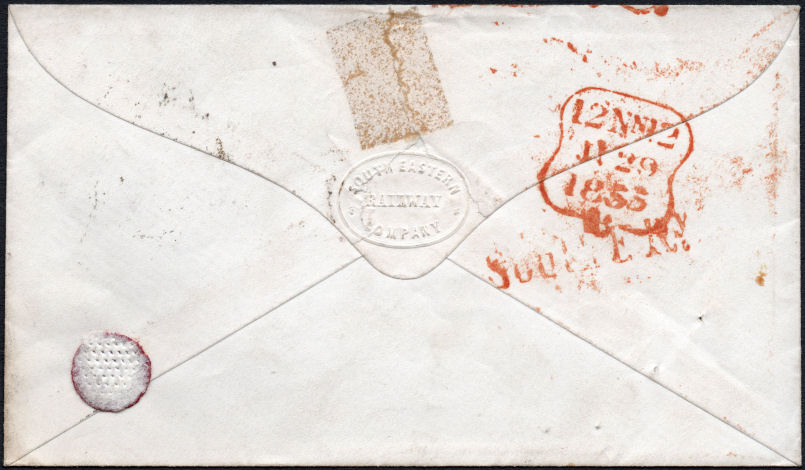
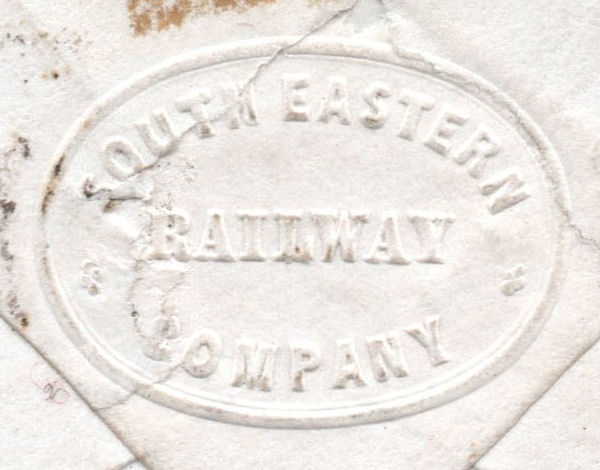
Images courtesy of Steve Lawrie.
Last updated 9th. November 2023
©Copyright Steve Panting 2012/13/14/15/16/17/18/19/20/21/22/23 except where stated.
Permission is hereby granted to copy material for which the copyright is owned by myself, on condition that any data is not altered and this website is given credit.